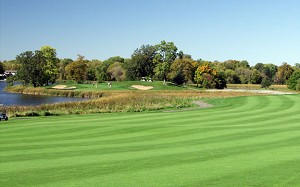Wild Marsh – A Graham Marsh Original
By Steve Manthis
If you’re like me, you’ve noticed some courses have names that really don’t make much sense. Either there’s some obscure, long since forgotten reference that led to the course’s name, or someone just pulled it out of a hat. Wild Marsh Golf Club in Buffalo, is not one of those courses. The name itself lets you know what you’re in for right from the get go. The marsh that’s in the name is the predominant feature of the golf course; in fact, it’s easy to lose track of how many times you’ll need a bridge to cross part of that marsh (FYI: it’s 9). While the marsh is ever present, it’s not all the course has to offer. What you’ll notice is that the course consists of several different types of holes that provide a variety of challenges, both from the tee and from the fairway.
Since the marsh is so prevalent, let’s start with it; there are a handful of forced carry tee shots. While these can be intimidating, none of them are unrealistically long, and playing the appropriate tees can ease their difficulty. Director of Golf Joe Malone says, “Like all courses, play the right tee and you’ll have a lot of fun at Wild Marsh.” For example, the 12th hole is a sharp dogleg left. From the black tees, the hole measures 424 yards which leaves a 200+ yard carry over the marsh to get to the fairway. From there, it’s a short iron to the green. However, the blue tees (370 yards) and the white tees (316 yards) offer shorter carries to the same landing area, and the red tees have no marsh to hit over at all. Malone goes on to say that, “Wild Marsh really is a great course for all golfers, women too.” On the holes where there’s no getting around the marsh, they have provided drop areas to limit the penalty.
Beyond the tee shots, though, Wild Marsh provides golfers with many different approach shots, and that’s what I enjoyed the most about the course. There are downhill shots to the green, level shots and uphill shots. The par four 6th hole is particularly fun. After a tee shot over the marsh, the 2nd shot is to a green that’s about 25 feet above where you’ll be hitting from. You’ll have a short iron to the green, but be sure to take enough club.
Besides the changes in elevation, there are also plenty of opportunities for uneven lies. The par four 15th hole is a dogleg left that measures 380 yards from the black tees and 360 from the blues, and asks you to decide how close you want to get to the green. Aim left and you can leave yourself with a short approach, but you’ll also have to hit over part of the marsh to get there. Plus, right-handed golfers will likely have the ball well above their feet. Play it safer and you’ll avoid having to hit over the marsh, but you’ll be left with a flatter lie for the second shot.
Probably the most recognizable hole is the par five 7th. There is a lake along the entire left side of the hole and you have to cross a marsh-like arm of the lake with the approach shot. It’s a visually intimidating hole, but, if you play it correctly, it doesn’t have to be a place to lose strokes. It’s best to play it as a three shot hole. In other words, there’s no reason you have to hit a driver off the tee as you’ll likely be hitting a lay up for the next shot. What’s important is the placement of your second shot. Find the 150 yard marker, and try to hit your ball just past it. Years ago, the shot to the green was much longer, but Malone says they’ve added about 60 yards of fairway, leaving a much shorter approach.
Besides the extra room on #7, Malone says they’ve done lots of work on the bunkers and the tee boxes, not to mention the restaurant above the pro shop. One member I spoke to said that the course “has been very plush. The members are all very happy.”
My last word on Wild Marsh is this: Don’t let its location stop you from going. Buffalo is about 30 minutes from the northwest suburbs. Replays are $10 for nine holes and $20 for eighteen. Head up that way and do what Malone suggests: Make a day of it.




